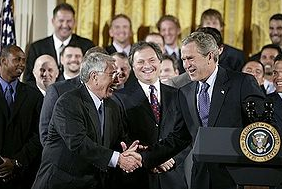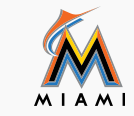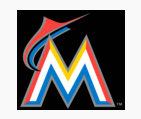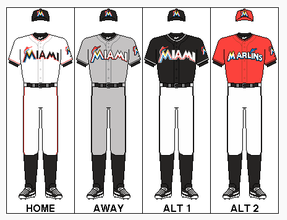
| Miami Marlins | |||||
| 2013 Miami Marlins season | |||||
| Established | 1993 | ||||
|
|||||
| Major league affiliations | |||||
|
National League (1993–present) East Division (1993–present) |
|||||
| Current uniform | |||||
|
|||||
| Retired numbers | 42 · | ||||
| Colors | |||||
|
Black, Red-Orange, Silver, Blue, Yellow, White |
|||||
| Name | |||||
| Miami Marlins (2012–present) | |||||
| Florida Marlins (1993–2011) | |||||
| Other nicknames | |||||
| The Fish, The Fightin' Fish, Miracle Marlins | |||||
| Ballpark | |||||
|
Marlins Park (2012–present) Sun Life Stadium (1993–2011) |
|||||
| Major league titles | |||||
| World Series titles (2) | 2003 · 1997 | ||||
| NL Pennants (2) | 2003 · 1997 | ||||
| East Division titles (0) | |||||
| Wild card berths (2) | 2003 · 1997 | ||||
| Front office | |||||
| Owner(s) | Jeffrey Loria | ||||
| Manager | Mike Redmond | ||||
| General Manager | Michael Hill | ||||
| President of Baseball Operations | David Samson | ||||
The Miami Marlins are a professional baseball team based in Miami, Florida and a member of the Eastern Division of Major League Baseball (MLB's) National League. Their home park is Marlins Park.
The Miami Marlins began play in the 1993 season as the Florida Marlins. They played home games from their inaugural season to the 2011 season at Sun Life Stadium, which they shared with theMiami Dolphins of the National Football League (NFL) and which was also called Joe Robbie Stadium, Pro Player Park, Pro Player Stadium, Dolphin Stadium, Dolphins Stadium, and Land Shark Stadium during their tenancy. Beginning with the 2012 Major League Baseball season, they play at Marlins Park in downtown Miami, on the site of the former Orange Bowl. The new park, unlike Sun Life Stadium (which was criticized in its baseball configuration for poor sight lines in some locations), was designed foremost as a baseball park. The new park's name is a temporary one until naming rights are purchased.[1][2] Per agreement with the city and Miami-Dade County (which owns the park), the Marlins officially changed their name to the "Miami Marlins" on November 11, 2011. They also adopted a new logo, color scheme, and uniforms.
The Marlins have the distinction of winning a World Series championship every year they qualified for the postseason, doing so in 1997 and 2003 — both times as the National League wild cardteam. They defeated the American League champion Cleveland Indians in the 1997 series, which was notable for shortstop Edgar Rentería driving in second baseman Craig Counsell for the series-clinching run in the eleventh inning of the seventh and deciding game and the "fire sale" which occurred in the off-season following the dramatic win. The 2003 season was notable for the firing of manager Jeff Torborg after thirty-eight games. The Marlins were in last place in the National League East with a 16-22 record at the time. Torborg's successor, 72-year-old Jack McKeon, led them to the National League's wild card berth in the playoffs; they defeated the New York Yankees four games to two in the 2003 World Series.
Franchise history
1990-1996: Birth of the Marlins
On March 7, 1990, Wayne Huizenga, CEO of Blockbuster Entertainment Corporation, announced he had purchased 15 percent of the NFL's Miami Dolphins and 50 percent of the Dolphins' home, Joe Robbie Stadium, for an estimated $30 million. Huizenga stated his intention to aggressively pursue an expansion franchise. MLB had announced a few months earlier that it intended to add two new teams to the National League. It was a foregone conclusion that one of them would be placed in Florida; the only question was whether Huizenga would beat out competing groups from Orlandoand Tampa Bay. Orlando fielded a very spirited campaign bolstered by its family-oriented tourism industry. Tampa Bay already had a baseball park—the Florida Suncoast Dome in St. Petersburg, completed in 1990. However, on June 10, 1991, the National League awarded a Miami-based franchise to Huizenga for a $95 million expansion fee. One name considered early on was the Florida Flamingos.[3]
In November 1991, the Marlins hired Fredi González as the Marlins first Minor League manager.
On December 16, 1991, they made their first-ever signing, inking 16-year-old Dominican pitcher Clemente Núñez to a contract.[4] They selected catcher Charles Johnson of the University of Miami with their first-ever first round draft pick in June 1992. Later that year Marlins President Carl Barger collapsed and died at the baseball winter meetings in Louisville, Kentucky. The Marlins later retired the number 5 in honor of Barger's favorite player, Joe DiMaggio.
The Marlins' first manager was Rene Lachemann, a former catcher who had previously managed the Seattle Mariners and Milwaukee Brewers, and who at the time of his hiring was a third base coach for the Oakland Athletics. The team drafted its initial lineup of players in the 1992 MLB Expansion Draft. The Marlins defeated the Houston Astros 12–8 in their inaugural Spring Training game. Jeff Conine hit Florida's first homer before a crowd of 6,696 at the Cocoa Expo Sports Complex. The Marlins won their first game on April 5, 1993, against the Dodgers. Charlie Hough was the starting pitcher for that game. Jeff Conine went 4-4 as well, making him an immediate crowd favorite. By the end of his tenure with Florida, he would earn the nickname "Mr. Marlin." Gary Sheffield and Bryan Harvey represented the Marlins as the club's first All-Star Game selections, and Sheffield homered in the Marlins first All-Star Game at-bat. The team finished the year five games ahead of the last-place New York Mets and with an attendance of 3,064,847. In that season, the Marlins traded their young set-up reliever Trevor Hoffman and two minor-league prospects to the San Diego Padres for third baseman Gary Sheffield. While Sheffield helped Florida immediately and became an all-star, Hoffman eventually emerged as the best closer in the National League. After the 1993 season, Donald A. Smiley was named the second President in club history. The Marlins finished last (51–64) in their division in the strike shortened season of 1994 and fourth (67-76) in 1995. Lachemann was replaced as manager midway through the 1996 season by director of player development, John Boles.
The Marlins had some bright spots on the mound and behind the plate in 1996. The team's 3.95 ERA ranked third in the NL, thanks in large part to newcomer Kevin Brown, who finished the season with a 17–11 win-loss record and an impressive 1.89 ERA. On May 11, Al Leiter pitched the first no-hitter in Marlins history. Catcher Charles Johnson led the league with a .995 fielding percentage, threw out a league-high 48 percent of base runners, and collected his second straightGold Glove Award for fielding excellence. After a slow start, the Marlins finished the year with an 80–82 win-loss record to place third in their division. Boles returned to his previous position as director of player development, and former Pittsburgh Pirates manager Jim Leyland was hired to lead the club in 1997.
1997: First World Series title/ The Fire Sale
Main article: 1997 Florida Marlins season
In addition to hiring Leyland as manager, the Marlins signed third baseman Bobby Bonilla, outfielder Moisés Alou, and pitcher Alex Fernandez to lucrative free-agent contracts, raising expectations to levels far beyond anything in franchise history.
The Marlins' franchise got its second no-hitter from ace Kevin Brown on June 10, 1997. Brown nearly had a perfect game, but he hit the Giants' Marvin Benard with a pitch in the 8th inning when Benard attempted to bunt. With Brown, Leiter and Fernandez heading the rotation, and Robb Nen closing out games, the Marlins' staff was almost systematic during their regular season run. In 1997, the Marlins finished nine games back of the Division Champion Atlanta Braves, but earned the wild card berth. Veteran additions such as LF Moisés Alou, 3B Bobby Bonilla, and trade-deadline additions Darren "Dutch" Daulton and Jim Eisenreich added experience and clutch hits. Talented young stars provided solid defensive play with catcher Charles Johnson setting a major league record by playing in 123 games without committing a single error, while Luis Castillo (2B) and Edgar Rentería (SS) comprised one of the best double play combos in the League.[5][6]Castillo did not perform to expectations offensively, and was replaced by Craig Counsell before the playoffs began. The Marlins swept the San Francisco Giants 3–0 in the National League Division Series, and then went on to beat theAtlanta Braves 4–2 in the National League Championship Series, overcoming the loss of Alex Fernandez to a torn rotator cuff, and Kevin Brown to a virus. Brown's place was taken in Game 5 by rookie pitcher Liván Hernández, who had earned a spot in the rotation in the second half of the season, but was not in the rotation during the postseason. Hernandez struck out 15 Braves and outdueled multiple Cy Young award-winner Greg Maddux to a 2–1 victory and a 3–2 series lead. Brown returned to the mound for Game 6, pitching a complete game victory to secure the Marlins their first-ever National League pennant. The underdog Marlins went on to face the Cleveland Indians in the 1997 World Series, and won in seven games. In Game 7, Craig Counsell's sacrifice fly in the bottom of the ninth tied the game at 2, then, with the bases loaded and two outs in the bottom of the 11th, Edgar Rentería's soft liner glanced off the glove of Cleveland pitcherCharles Nagy and into center field to score Counsell and give the Marlins the win.
Following the World Series victory, Huizenga dismantled the team, claiming financial losses despite having won the World Series. He traded most of the club's best players in one of the biggest fire sales in sports history. The first deal came days after the World Series, when the Marlins traded outfielder Moisés Alou to the Houston Astros for pitchers Oscar Hernandez and Manuel Barrios. The team then traded Kevin Brown to the San Diego Padres for Derrek Lee and two minor leaguers. Finally, in May 1998, they dealt Bobby Bonilla, Gary Sheffield, Charles Johnson, Jim Eisenreich, and Manuel Barrios to the Los Angeles Dodgers for Mike Piazza and Todd Zeile, both of whom would be gone via trades by midseason. On the flip side, these trades brought promising youngsters Derrek Lee and A. J. Burnett.
1998-2002: Last Place Finishes, New ownership
Main article: 1998 Florida Marlins season
The Marlins' 1998 slumped to 54–108, the worst record in the major leagues that year, and the most losses in franchise history. They are the only team to lose 100 games a year after winning the World Series. Leyland resigned as manager in October 1998, and was replaced by John Boles. Huizenga soon sold the club to John Henry, a commodities trader from Boca Raton, during the off-season. The Marlins had the second overall pick in the 1999 draft and drafted Josh Beckett from the state of Texas.
In 1999, the Marlins were the first MLB team to host a game in which Instant Replay was used.[7] While playing the Cardinals, Cliff Floyd hit a ball to the top of the left field scoreboard. Originally ruled a home run, NL Umpire Frank Pullireversed the call to a double, after consulting a dugout TV monitor. The Cardinals won the game, 5–2. After the game, the NL League Office declared the umpires erred in using Instant Replay. MLB would not use Instant Replay again for almost a decade.[8] The Marlins finished the 1999 season with the worst record in baseball at 64–98, and traded World Series MVP Liván Hernández to the San Francisco Giants. The Marlins also drafted P Johan Santana from Houston in the Rule 5 draft but traded him to Minnesota in a prearranged deal for P Jared Camp.
A month prior to the regular season, the Marlins hired David Dombrowski as the third President in club history, making him both President and General Manager. After posting the worst record in baseball for the 1999 season, the Marlins had the first overall pick in the 2000 first-year player draft and selected first baseman Adrian Gonzalez, a 16-year-old native of Bonita, California. The Eastlake High School product agreed to terms with the Marlins that same day. The Marlins went on that season to finish 79–82 and third place in the NL East. This was thanks to the emergence of OF Preston Wilson who had 31 home runs and 121 RBIs. Derrek Lee and Luis Castillo broke out this year as well, as Castillo posted a .334 batting average and Lee had 28 homers in his first full season. Antonio Alfonseca posted a then-club record 45 saves.
The club slowly worked its way back to respectability with a third place finish in 2000, driven by young stars such as A. J. Burnett, Brad Penny, Preston Wilson, Luis Castillo, and Mike Lowell. Burnett pitched the Marlins' third no-hitter on May 12 against the Padres, 2001, despite walking nine batters and throwing only 1/2 of his pitches for strikes. Three weeks after the no-no, Manager John Boles was fired and Hall of Famer Tony Pérez was named interim manager for the rest of the season. The club finished 76–86 and in fourth place, thanks to Brad Penny's and A. J. Burnett's emergence.
The offseason following the 2001 regular season included an overhaul of the ownership and front office. Tony Pérez resigned and returned to his previous role as the front-office Baseball Operations assistant. About a month later, David Dombrowski resigned as President and General Manager of the Florida Marlins and accepted the position as President of the Detroit Tigers. Entering the new year, Henry sold the Marlins to Montreal Expos owner Jeffrey Loria, clearing the way for Henry to buy the Boston Red Sox. Loria brought the entire Expos management and coaching staff to the Marlins. David Samson became team president, Larry Beinfest became General Manager and Jeff Torborg became manager.
Prior to the 2002 season, the Marlins traded RHP Matt Clement and RHP Antonio Alfonseca to the Cubs for RHP Julián Tavárez, LHP Dontrelle Willis, RHP Jose Cueto and C Ryan Jorgensen. The Marlins had their ups as Luis Castillo had a team record 35 game hitting streak and Kevin Millar had 25 game hit streak. Around the all-star break they made their second big trade sending OF Cliff Floyd to the Expos for RHP Carl Pavano, RHP Justin Wayne, INF Mike Mordecai, LHP Graeme Lloyd, RHP Don Levinski and INF Wilton Guerrero. The same day, the Fish dealt RHP Ryan Dempster to the Cincinnati Reds for OF Juan Encarnación and LHP Ryan Snare. The Marlins finished 79–83, second best season in team history up to that time, but their fifth straight losing season since winning the World Series.
Nonetheless the Marlins showed promise entering the offseason as they had a rotation of Josh Beckett, Carl Pavano, Brad Penny, and A. J. Burnett.
The Marlins also turned their first ever triple play in franchise history on July 28, 2002.
2003-2005: Second World Series title/ The Jack McKeon Era

Members of the 2003 Florida Marlins championship team with President Bush after their win.
Main article: 2003 Florida Marlins season
During the offseason, the Marlins signed free agent catcher Iván Rodríguez - a 10-time Gold Glove Award winner - and acquired speedy outfielder Juan Pierre from the Colorado Rockies hoping to offset the loss of sluggers Cliff Floyd and Preston Wilson. The Marlins did acquire P Mike Hampton but dealt him and his hefty contract to the Braves for P Tim Spooneybarger.
The Marlins struggled in the opening stages of the season, going 16–22. During that span, Florida lost its top three pitchers: A. J. Burnett, Josh Beckett, and Mark Redman. On May 11, Florida replaced manager Jeff Torborg with 72-year-old Jack McKeon. On May 22, the Marlins hit bottom with a major league worst record of 19–29, having lost 6 straight games. However, help was on the way.
On May 9, the Marlins called up high-kicking southpaw Dontrelle Willis from the Double-A Carolina Mudcats and helped carry the injury-plagued Marlins with an 11–2 record in his first 17 starts. Miguel Cabrera (also from the Mudcats) filled in well, hitting a walk off home run in his first major league game, against the Tampa Bay Devil Rays at Pro Player Stadium. Both Willis and Cabrera would later prove to be essential parts of the Marlin's playoff success. Jeff Conine - an original Marlin and member of the 1997 World Series team - returned from Baltimore, and closer Ugueth Urbina arrived from the Texas Rangers. These acquisitions helped to keep the team in contention, and although they finished ten games behind the Braves, the Marlins captured the NL wild card.
The Marlins won the Division Series against the favored San Francisco Giants three games to one. The series ended with a dramatic collision between Marlins catcher Rodríguez and Giants first baseman J. T. Snow, making it the first postseason series ever to end with the potential tying run being thrown out at the plate.
On October 15, the Marlins defeated the Chicago Cubs four games to three in the Championship Series, coming back from a three games to one deficit. A Beckett complete-game shutout in Game 5 kept the Marlins alive. Game 6 saw the Marlins play a role in one of baseballs most infamous moments: "The Inning" . With 1 one out in the 8th inning and the Cubs 3 runs ahead, Marlins 2nd baseman Luis Castillo hit a pop foul a row into the stands along the third base line. Cubs fan Steve Bartman reached for the ball, preventing Cubs LF Moisés Alou from making the out and setting off an 8-run Marlins rally. The incident with Steve Bartman and a come-from-behind win inWrigley Field in Game 7 helped the Marlins capture their second NL pennant, keeping the "Curse of the Billy Goat" alive and well.
In the 2003 World Series, the Marlins defeated the heavily favored New York Yankees in six games, winning the sixth game in Yankee Stadium. Shortstop Álex González helped the Marlins in Game 4 of the series with a walk off home run in extra innings. Josh Beckett was named the Most Valuable Player for the series after twirling a five-hit complete-game shutout in Game 6. Skipper Jack McKeon became the oldest manager ever to win a World Series title. The Marlins became the first opposing team to win a Series championship on the field at Yankee Stadium since the 1981 World Series, when the Los Angeles Dodgers did it. The Marlins are also the last team to win a World Series at the Old Yankee Stadium. The Marlins won the series despite scoring fewer runs (17) than the Yankees (21).
The offseason after their second World Series title, the Marlins made a questionable cost-cutting move as Derrek Lee was traded to Chicago Cubs for Hee-seop Choi and pitcher Mike Nannini. The Marlins also lost key parts of their second championship team, Ugueth Urbina and Iván Rodríguez left via free agency (signed by the Detroit Tigers). Marlins third base coach Ozzie Guillén also departed to be manager of the Chicago White Sox. The Marlins did get good news though asDontrelle Willis was named NL Rookie of the Year and Jack McKeon named Manager of the Year. They also signed Mike Lowell to a new four-year contract.






















